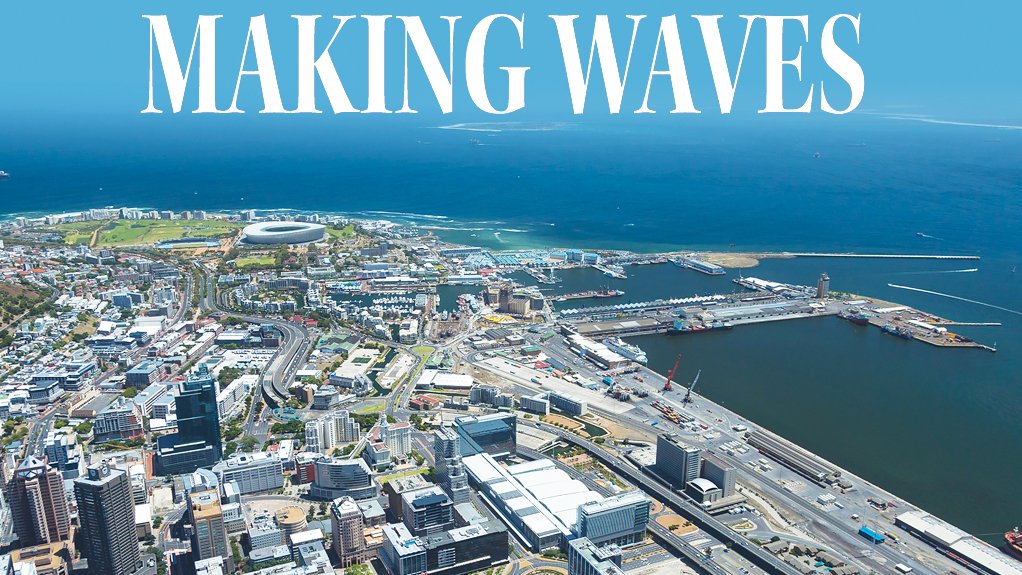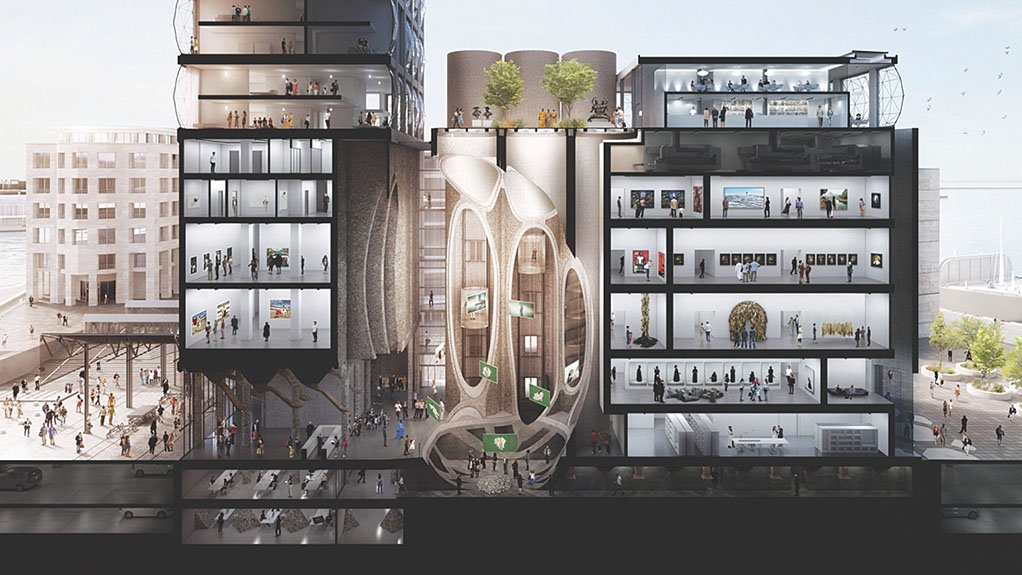Cape Town’s V&A Waterfront swims against sluggish economic tide





Photo by Courtesy of the Cape Town Central City Improvement District
HIVE OF ACTIVITY An overhead view of developments taking place at the Silo District as at the end of January
ARTIST’s IMPRESSION The Zeitz Museum of Contemporary African Art is set to be a ‘jewel in the V&A crown’ and will be home to 80 gallery spaces
NEW TERMINAL Cape Town’s first cruise liner terminall is expected to be completed in December 2017
Cape Town’s V&A Waterfront is bucking the sluggish trend in the national economy. It pulled in over three-million visitors in December alone, has substantially boosted its coffers and has embarked on some dynamic new developments.
Retail, commercial, leisure and residential developments are all included in the 123 ha mix.
The 26-year-old V&A Waterfront receives more than 24-million visitors each year. While the V&A is clearly a tourist hub, locals make up the largest share of visitors, at 63%. Tourists make up just short of a quarter of the number of people who visit, with upcountry travellers making up the remaining 14%.
“Our vision is to be the best waterfront in the world, but we also want to continue to be a space which locals love and celebrate,” says V&A Waterfront CEO David Green.
So far, the V&A seems to be hitting the sweet spot by diversifying and appealing to various markets.
The most hotly anticipated development is the Zeitz Museum of Contemporary African Art (Zeitz MOCAA) in the historic grain silo district of the V&A. Green describes the grain silos as a phenomenal piece of industrial architecture, which are being repurposed by the ‘magic and genius’ of renowned British architect Thomas Heatherwick.
“The redevelopment plan specifically aims to retain and honour the historic fabric and soul of the Grain Silo building, in which the Zeitz MOCAA will be housed, while transforming the interior into a unique cutting-edge space to house the collection,” says Green.
When it is completed next year, it will be the largest museum built in Africa for over 100 years – since the Egyptian Museum of Antiquities, in Cairo.
The aim is to harness the growing interest in contemporary African art and bring together collections of African art from across the world.
The museum is also seen as a drawcard for attracting more tourists. CEO of Cape Town Travel Enver Duminy says the Zeitz MOCAA is set to be a ‘jewel in the V&A crown’ and will be home to 80 gallery spaces. The R500-million investment in the MOCAA dovetails with various others in the area.
Four new silo developments will hold 35 000 m2 of new corporate offices, a Virgin Active Classic Health Club, a residential development, a midrange internationally branded hotel and over 1 050 additional parking bays. The road leading to the silo area will be widened to accommodate the expected increase in traffic.
Green Building First
The V&A has been working with the Green Building Council of South Africa to develop a new mixed-use tool which will be a first for South Africa. The new developments in the precinct will be located on top of the 2 750 parking bay super basement that will house the district seawater cooling plant and a number of other services, including sprinkler tanks, backup generators and diesel storage, potable water and gas.
With Silo 1 and 2 already completed, this will bring the total investment in the silo development by V&A shareholders, Growthpoint and the Government Employees Pension Fund, managed by the Public Investment Corporation, to over R2.5-billion.
About 2 500 people are expected to work at the Silo district every day once it is up and running. Currently, over 19 200 people are directly employed at the V&A, with another 16 894 indirect jobs.
Cape Town’s first cruise liner terminal is also being developed at the V&A. The terminal upgrade will make up the first phase of a larger site revamp. The passenger terminal is expected to be completed in December 2017.
Given that the cruise industry is seasonal, the terminal will be developed and run as a multiuse building, which can operate all year round.
“The cruise terminal gives us the opportunity to extend a warm welcome to Cape Town, and is important as it’s the first impression it will create of the city,” says Green.
An increasing number of people are also calling the Waterfront home, with residential developments becoming popular and prices on the rise. The new No 3 Silo residential development will comprise 75 luxury one- to four-bedroom apartments, with the same environmentally sustainable elements used in the No 2 silo.
The V&A recently introduced its first rental developments, which has attracted young professionals. “The Ports Edge and Breakwater areas cater to a younger professional market that are not yet committed to buying property, but want to live and work and play in an urban-chic environment,” says Green.
Rooftop Energy
The Waterfront has included green technologies in the build phases of its developments as well as retrofitting onto existing buildings. A 7 500 m2 rooftop solar system was installed on six rooftops of major buildings in the precinct last year. Working with the Green Building Council of South Africa, the V&A has set a target of achieving at least a four-star Green Star SA rating for its buildings.
The R50-million Watershed, which makes up the old Red and Blue craft markets at the Waterfront, has also gained ground. Made up mostly of craft and design businesses and traders, it tripled its retail trade in the 12 months from the end of 2014 to the end of 2015. A street was created through the physical building, turning it into a multi- functional space.
The new development has sparked innovation and creativity, with designers sharpening their skills there. Small businesses now make up between 3% and 4% of the overall retail trade at the Waterfront, up from 1% a year ago.
The Waterfront, which has 22 official landmarks on site, is part of south Africa’s historical legacy. It was developed in 1988 by Transnet Limited, with official commercial trading getting under way in November 1990.
Now, 26 years later, the V&A has contributed R33-billion to the South African gross domestic product. This is nearly four times more than in 2002. With tourism identified as a key growth sector in the province overall, MEC for Economic Opportunities Alan Winde says the Cape Town Air Access team is finalising negotiations for nonstop flights between Cape Town and key strategic destinations in Africa, Asia and the US.
CBD Reconnection
The revitalisation of the V&A has also blended with changes in Cape Town’s central business district (CBD).
“For many years, the V&A overshadowed the central city. We would like to think that the new-found popularity and investor confidence in the CBD has helped to contribute to the new-found investor confidence in the V&A. The two areas complement each other very well these days, and the reconnection is highly beneficial to both,” says Rob Kane, chairperson of the Cape Town Central City Improvement District.
He says that, for a number of decades, there has been a disconnect between the central city district and the sea, largely owing to the town planning of the 1930s and 1940s, when the area known as the Foreshore today was reclaimed from the sea to extend the harbour.
Harbour infrastructure, together with the freeway network built across the Foreshore effectively cut off the rest of the CBD from Table Bay harbour. But the vacant lots and car parks of the past have been transformed into an increasingly vibrant area. Investors are ploughing R8.2-billion into developments in the area over the next three to five years, from the construction of a new state-of-the-art hospital and the expansion of the Cape Town International Convention Centre (CTICC) to new office complexes, international hotels and residential accommodation.
“Simultaneously, the V&A has developed. We are now seeing the two areas – the CBD and the V&A – move closer and closer together, reconnecting again for the first time in nearly 90 years. This is huge for the city and overall,” says Kane.
The R700-million ‘Canal District’ straddling both sides of Dock road, in Cape Town, is testament to this. With a canal at its heart, the area will have a new urban park incorporating the remnants of the historical Amsterdam Battery. Totalling 75 000 m2 (or 7.6 ha), the mixed-use Canal District ties into the arterial route that connects the city to the V&A, and into the main pedestrian route that runs along Dock road.
A corporate head office for British American Tobacco South Africa (BAT South Africa) is the first project in this new area. Called Amsterdam House, the building has been designed according to best practice green design principles.
“The Canal District is a piece in the jigsaw puzzle that provides a seamless link through to the CTICC and Cape Town’s CBD,” says Green.
The 2010 FIFA World Cup has been given some credit for hiking interest in the Cape Town CBD and the V&A, with many locals reconnecting with the CBD for the first time in a long time.
For Green, the V&A provides endless scope for cascading development in Cape Town.
“A waterfront cannot be viewed in isolation. It is an extension and neighbourhood of the city, not just an attraction,” he says.
The Waterfront’s being intrinsic to the V&A’s development has been immensely rewarding for Green.
“It is not only the pride of the people who work here that energises me, but seeing the pride that South Africans hold. History, industry, commerce and tourism are intertwined to make this an incredibly special place.”
Article Enquiry
Email Article
Save Article
Feedback
To advertise email advertising@creamermedia.co.za or click here
Comments
Press Office
Announcements
What's On
Subscribe to improve your user experience...
Option 1 (equivalent of R125 a month):
Receive a weekly copy of Creamer Media's Engineering News & Mining Weekly magazine
(print copy for those in South Africa and e-magazine for those outside of South Africa)
Receive daily email newsletters
Access to full search results
Access archive of magazine back copies
Access to Projects in Progress
Access to ONE Research Report of your choice in PDF format
Option 2 (equivalent of R375 a month):
All benefits from Option 1
PLUS
Access to Creamer Media's Research Channel Africa for ALL Research Reports, in PDF format, on various industrial and mining sectors
including Electricity; Water; Energy Transition; Hydrogen; Roads, Rail and Ports; Coal; Gold; Platinum; Battery Metals; etc.
Already a subscriber?
Forgotten your password?
Receive weekly copy of Creamer Media's Engineering News & Mining Weekly magazine (print copy for those in South Africa and e-magazine for those outside of South Africa)
➕
Recieve daily email newsletters
➕
Access to full search results
➕
Access archive of magazine back copies
➕
Access to Projects in Progress
➕
Access to ONE Research Report of your choice in PDF format
RESEARCH CHANNEL AFRICA
R4500 (equivalent of R375 a month)
SUBSCRIBEAll benefits from Option 1
➕
Access to Creamer Media's Research Channel Africa for ALL Research Reports on various industrial and mining sectors, in PDF format, including on:
Electricity
➕
Water
➕
Energy Transition
➕
Hydrogen
➕
Roads, Rail and Ports
➕
Coal
➕
Gold
➕
Platinum
➕
Battery Metals
➕
etc.
Receive all benefits from Option 1 or Option 2 delivered to numerous people at your company
➕
Multiple User names and Passwords for simultaneous log-ins
➕
Intranet integration access to all in your organisation


















